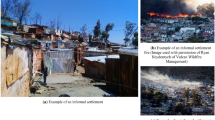Abstract
It has been implied that spatial separations based on peak radiation levels will prevent ignition by radiation, indefinitely. The specified distances, however, exceed practical limits. Separations calculated to prevent ignition by radiation long enough for fire extinguishing operations to be initiated have been tabulated. The author explains how the tables were derived and discusses problems that may be encountered in their use.
Similar content being viewed by others
References
“The St. Lawrence Burns,” G. W. Shorter, J. H. McGuire, N. B. Hutcheon, and R. F. Legget, NFPAQuarterly, Vol. 53, No. 4 (April 1960), pp. 300–316.
“Radiation from Building, Fires,” R. C. Bevan and C. T. Webster, Investigations on Building Fires—Part III, National Building Studies Technical Paper No. 5, 1950
“Heat Transfer by Radiation,” J. H. McGuire, Fire Research Special Report No. 2, 1953.
“Heat Radiation from fires and Building Separation,” M. Law, Joint Fire Research Organization Technical Paper No. 5, 1963.
Author information
Authors and Affiliations
Additional information
Note: This paper is a contribution of the Division of Building Research, National Research Council, Canada, and is published with the approval of the Director of the Division.
Rights and permissions
About this article
Cite this article
McGuire Sfpe, J.H. Fire and the spatial separation of buildings. Fire Technol 1, 278–287 (1965). https://doi.org/10.1007/BF02588470
Issue Date:
DOI: https://doi.org/10.1007/BF02588470




